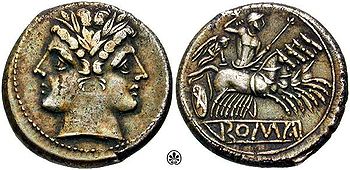
The denarius was the standard Roman silver coin from its introduction in the Second Punic War c. 211 BC to the reign of Gordian III, when it was gradually replaced by the antoninianus. It continued to be minted in very small quantities, likely for ceremonial purposes, until and through the Tetrarchy (293–313).

The as, occasionally assarius was a bronze, and later copper, coin used during the Roman Republic and Roman Empire.
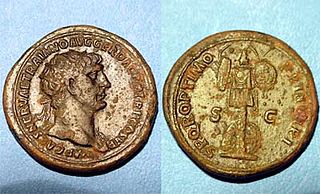
The dupondius was a brass coin used during the Roman Republic and Roman Empire valued at 2 asses.

Roman currency for most of Roman history consisted of gold, silver, bronze, orichalcum and copper coinage. From its introduction to the Republic, during the third century BC, well into Imperial times, Roman currency saw many changes in form, denomination, and composition. A persistent feature was the inflationary debasement and replacement of coins over the centuries. Notable examples of this followed the reforms of Diocletian. This trend continued into Byzantine times.
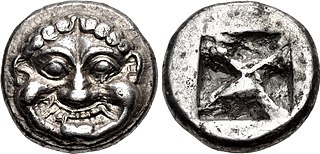
The history of ancient Greek coinage can be divided into four periods: the Archaic, the Classical, the Hellenistic and the Roman. The Archaic period extends from the introduction of coinage to the Greek world during the 7th century BC until the Persian Wars in about 480 BC. The Classical period then began, and lasted until the conquests of Alexander the Great in about 330 BC, which began the Hellenistic period, extending until the Roman absorption of the Greek world in the 1st century BC. The Greek cities continued to produce their own coins for several more centuries under Roman rule. The coins produced during this period are called Roman provincial coins or Greek Imperial Coins.

The victoriatus was a silver coin issued during the Roman Republic from about 221 BC to 170 BC. The obverse of the coin featured the bust of Jupiter and the reverse featured Victory placing a wreath upon a trophy with the inscription "ROMA" in exergue. The name victoriatus is an ancient term, attested by several contemporary texts and inscriptions. The coin was known as a tropaikon among Greek speakers.
Roman Republican currency refers to the coinage struck by the various magistrates of the Roman Republic, to be used as legal tender. In modern times, the abbreviation RRC, "Roman Republican Coinage" originally the name of a reference work on the topic by Michael H. Crawford, has come to be used as an identifying tag for coins assigned a number in that work, such as RRC 367.
Faustus Cornelius Sulla was a politician of the Roman Republic. He was the son of the dictator Lucius Cornelius Sulla. He started his career in the shadow of Pompey, whom he followed during the Civil War against Julius Caesar. He was killed soon after the battle of Thapsus in 46 BC.

Silver coins are considered the oldest mass-produced form of coinage. Silver has been used as a coinage metal since the times of the Greeks; their silver drachmas were popular trade coins. The ancient Persians used silver coins between 612–330 BC. Before 1797, British pennies were made of silver.

The triumvir monetalis was a moneyer during the Roman Republic and the Empire, who oversaw the minting of coins. In that role, he would be responsible for the "ordinary coinage" during the republican period. Roman moneyers almost always acted together as a board of three, hence their title triumvir.
Like the Egyptians, Phoenicians and Carthaginians, the Etruscans were rather slow to adopt the invention of coinage. The brief period of Etruscan coinage, with the predominance of marks of value, seems to be an amalgam that reconciles two very different monetary systems: the 'primitive' bronze-weighing and aes grave economy of central Italy with that of struck silver and gold issues of southern Italian Greek type not familiar in Etruria.

The gold dinar is an Islamic medieval gold coin first issued in AH 77 (696–697 CE) by Caliph Abd al-Malik ibn Marwan. The weight of the dinar is 1 mithqal.
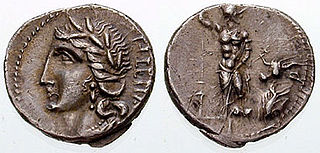
The family of Social War coinage includes all the coins issued by the Italic allies of the Marsic confederation, Marsi, Peligni, Piceni, Vestini, Samnites, Frentani, Marrucini, and Lucani, during the Social War against Rome.
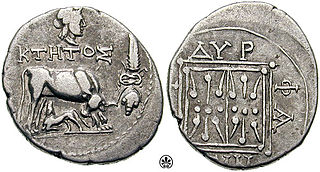
Illyrian coinage which began in the 6th century BC continued up to the 1st century of Roman rule. It was the southern Illyrians who minted the first coins followed by the northern Illyrian during the Roman era. Illyrian coins have also been found in other areas apart from Illyria, such ancient Macedonia, Italy, Greece, Asia Minor and Egypt.
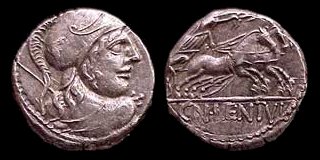
In the currency of ancient Rome, the bigatus is a type of denarius stamped on the reverse with a biga, a two-horse chariot. It began to appear in the first decade of the 2nd century BC as an alternative to the victoriatus, and most numismatists believe that it was not used before 190 BC. A denarius with a four-horse chariot (quadriga) had already been in use for some time; see quadrigatus, likewise named for its chariot icon and depicting in addition the Dioscuri.

The biga is the two-horse chariot as used in ancient Rome for sport, transportation, and ceremonies. Other animals may replace horses in art and occasionally for actual ceremonies. The term biga is also used by modern scholars for the similar chariots of other Indo-European cultures, particularly the two-horse chariot of the ancient Greeks and Celts. The driver of a biga is a bigarius.

Marcus Servilius Pulex Geminus was a Roman statesman during the Second Punic War, and the early decades of the second century BC. He was a renowned warrior, whose martial prowess was commemorated on coins issued by several of his descendants.
Carthaginian or Punic currency refers to the coins of ancient Carthage, a Phoenician city-state located near present-day Tunis, Tunisia. Between the late fifth century BC and its destruction in 146 BC, Carthage produced a wide range of coinage in gold, electrum, silver, billon, and bronze. The base denomination was the shekel, probably pronounced in Punic. Only a minority of Carthaginian coinage was produced or used in North Africa. Instead, the majority derive from Carthage's holdings in Sardinia and western Sicily.
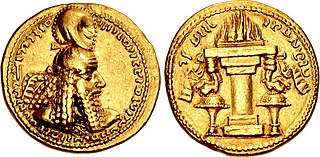
Sasanian coinage was produced within the domains of the Iranian Sasanian Empire (224–651). Together with the Roman Empire, the Sasanian Empire was the most important money-issuing polity in Late Antiquity. Sasanian coinage had a significant influence on coinage of other polities. Sasanian coins are a pivotal primary source for the study of the Sasanian period, and of major importance in history and art history in general. The Sylloge nummorum Sasanidarum is the most important primary work of reference for Sasanian coins.

Legionary denarii is the modern name for a series of Roman silver denarius coins issued by Mark Antony in the eastern Mediterranean during the last war of the Roman Republic from 32 to 31 BC, in the lead up to the Battle of Actium. The coinage is also referred to by numismatists as RRC 544/1-39, after its designation in M. H. Crawford, Roman Republican Coinage (1975).
